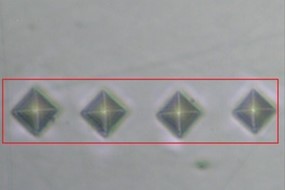
Peningkatan Akurasi Parameter Kisi Kristal dalam Analisis Difraksi Sinar-x (XRD) Melalui Karakterisasi Koreksi Titik Nol
Abstract
The characterization of the zero point correction (2θ0) has been carried out for several XRD instruments using the NIST SRM 640d Silicon standard sample. This research was conducted to determine the 2θ0 position of three diffractometers, namely Shimadzu XRD-7000 Maxima-X at Hasanuddin University Makassar, Philips PW 1710 at the University of Indonesia and Pan Analytical X-Pert Pro at Malang State University. This 2θ0 cost was performed using Fityk for single-line analysis and Rietica for Rietveld analysis. This study shows that each instrument has different characteristics of the zero point position referring to the difference in optical arrangement. The results of this study confirmed that the results of the XRD analysis using the Rietica program which had been corrected with 2θ0 99.79% were close to the values of the calculated lattice parameters.
Keywords
Full Text:
PDFReferences
S.-M. Lee, S.-H. Lee, and J.-S. Roh, "Analysis of Activation Process of Carbon Black Based on Structural Parameters Obtained by XRD Analysis" Crystals, vol. 11, no. 2, Art. no. 2, Feb. 2021, doi: 10.3390/cryst11020153.
"Size Dependence of Lattice Parameter and Electronic Structure in CeO2 Nanoparticles | Inorganic Chemistry." https://pubs.acs.org/doi/10.1021/acs.inorgchem.0c00506.
T. Amutha, M. Rameshbabu, S. Muthupandi, and K. Prabha, "Theoretical comparison of lattice parameter and particle size determination of pure tin oxide nanoparticles from powder X-ray diffraction" Materials Today: Proceedings, vol. 49, pp. 2624-2627, Jan. 2022, doi: 10.1016/j.matpr.2021.08.044.
C. Ragavendran et al., "Eco-Friendly Approach for Zno Nanoparticles Synthesis and Evaluation of its Possible Antimicrobial, Larvicidal and Photocatalytic Applications." Rochester, NY, Feb. 15, 2023. doi: 10.2139/ssrn.4359726.
B. H. O'Connor and S. Pratapa, "Improving the accuracy of Rietveld-Derived Lattice Parameters By an Order of Magnitute" Advances in X-Ray Analysis, vol. 45, pp. 158-165, 2002.
R. Allmann, "General data reduction" in Powder Diffraction: Theory and practice, D. Robert E. and B. Simon J., Eds. Cambridge: RSC Publishing, 2008.
J. K. Cockcroft and A. N. Fitch, "Experimental Setups" in Powder Diffraction: Theory and practice, R. E. Dinnebier and B. Simon J., Eds. Cambridge: RSC Publishing, 2008.
A. Nurhayati and S. Pratapa, "Development of Yttria and Corrundum for Line Broadening Standard in X-Ray Diffraction Data Analysis" pp. 256-259, 2008.
Match! Phase Identification from Powder Diffraction. Germany: Crystal Impact, 2003.
B. A. Hunter and C. J. Howard, Manual for Rietica: A computer program for Rietveld analysis of X-ray and neutron powder diffraction patterns. Australia: Lucas Heights Research Laboratories, 1997.
S. Pratapa, "X-Ray Diffraction phase analysis for granulated and sintered ceramic materials" Makara Sains, vol. 11, no. 2, pp. 85-89, Nov. 2007.
Paton M G and MaslenÿEÿN, "A Refinement of the crystal strucure of Yttria" Acta Crystallograhphica, vol. 1, no. 19, pp. 307-310, 1965.
Sawada H, "An electron density residual study of magnesium aluuminium oxide spinel" Materials Research Bulletin, vol. 30, no. 3, pp. 341-345, 1995.
Sasaki S, FujinoÿK, and TakeuchiÿY, "X-ray determination of electron-density distributions in oxides, Mg O, Mn O, Co O, and Ni O, and atomic scattering factors of their constituent atoms" Proceedings of the Japan Academy, vol. 55, pp. 43-38, 1979.
DOI: https://doi.org/10.34312/ljpa.v1i1.18560
Copyright (c) 2022

This work is licensed under a Creative Commons Attribution 4.0 International License.


